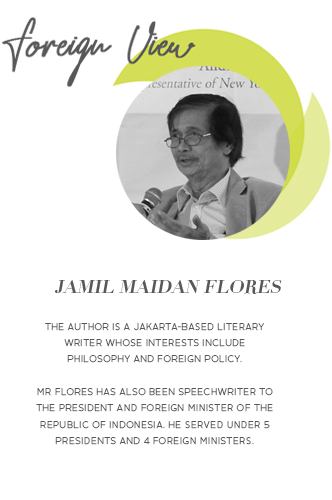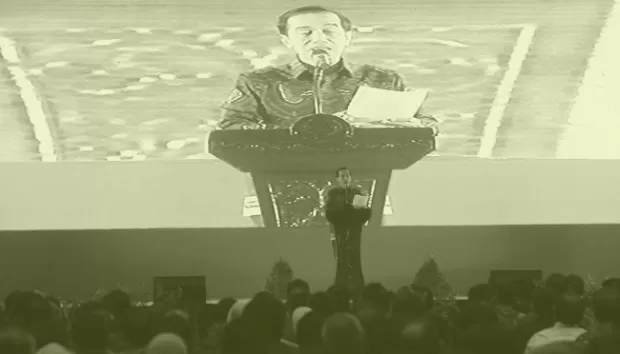 [dropcap]W[/dropcap]hen a person having a meal bites off more than he can chew and swallows it, the upshot can be a bad case of indigestion. An analogous situation can happen in the foreign policy realm when a nation assumes a diplomatic task so vast that the effort is bound to fizzle out.
[dropcap]W[/dropcap]hen a person having a meal bites off more than he can chew and swallows it, the upshot can be a bad case of indigestion. An analogous situation can happen in the foreign policy realm when a nation assumes a diplomatic task so vast that the effort is bound to fizzle out.
An overreach like this could have easily happened in one of the most important diplomatic initiatives of Indonesia recently. That has been averted, however, through good thinking by Indonesian senior officials and their counterparts from other ASEAN countries.
What is that initiative? In recent days, Indonesia has found itself once more in the role that it abandoned during the early months of the Jokowi administration, the role of leader in the arduous enterprise of ASEAN regional architecture building for the Indo-Pacific region. At once, the task looks overwhelmingly immense for it involves cobbling together nations enclosed by the rims of two oceans—the Indian Ocean and the Pacific Ocean—into a single regional architecture.
Too big to manage?
In fact, an early notion was to put together the Indian Ocean Rim Association (IORA), which has 21 members, and the Asia Pacific Economic Cooperation (APEC), which also has 21 members, to form the Indian Ocean regional architecture. That would mean a membership of 38, as four ASEAN members (Indonesia, Malaysia, Singapore and Thailand) are also members of both IORA and APEC.
You can hardly get more inclusive than that, if inclusiveness is your meat and drink, nor can you have anything more unwieldy.
There are, of course, still bigger organizations, such as the Non-aligned Movement (NAM), which has 120 members; the Group of 77; and the United Nations, which has 193 members. But these are global organizations, which have nothing to do with regional geopolitics on the ground.
The ongoing ferment for an Indo-Pacific regional architecture began early this year during the Asean Foreign Ministers’ Retreat in Singapore when Indonesia advocated the strengthening of the Indo-Pacific regional architecture, and it was agreed that this matter be placed on the agenda of the East Asia Summit (EAS) this coming November.
In a press release, Indonesian Foreign Minister Retno Marsudi asserted that “the Indo-Pacific region, comprising of tropical waters of the Indian Ocean, the western and central Pacific Ocean, and the seas connecting the two in the general area of Indonesia, has become a strategic region for global economic development and peace.”
She then proposed the holding of a 1.5 track Asean meeting to discuss and develop a concept of an Indo-Pacific regional architecture. That meeting was held soon enough in Jakarta and boasted some very interesting discussions.
Inclusive cooperation
In his presentation during the meeting, Dr. Siswo Pramono, head of the Foreign Ministry’s Policy Analysis and Development Agency, conjured an Indo-Pacific region that stretches from the East African Coast to the West Coast of the American continent.
He urged promoting “inclusive cooperation and synergizing the economies of the Indo-Pacific region.” There would be no need for creating a new framework of cooperation, he said. “It would be enough to empower the existing frameworks and mechanisms in the region.” He recommended the East Asia Summit (EAS) as the platform for shaping the Indo-Pacific regional architecture, since all the key players are in that forum.
Dr. Surya Chindawongse, Director-General of Asean Affairs of the Ministry of Foreign Affairs of Thailand, also batted for “Inclusiveness,” plus a raft of desiderata that included “Asean Centrality” and “Reliance on Existing Mechanisms.” He suggested the use of the EAS and the Asean Plus One mechanisms as platforms for developing the Indo-Pacific idea.
Two other speakers who encouraged the use of the EAS as a platform for discussion of the Indo-Pacific regional architecture were Ambassador Kan Pharidh, Undersecretary of State of the Cambodian Ministry of Foreign Affairs, and Ms. Sengdavan Vongsay, Deputy Director General, Asean Department of the Ministry of Foreign Affairs of Lao PDR.
Ambassador Jose Tavares, Director-General for ASEAN Cooperation of the Indonesian Foreign Ministry, who chaired the meeting, suggested that the strategic aspects of the EAS be strengthened, that linkages be established between EAS and other ASEAN-led mechanisms and that the EAS meet whenever there would be an emergency in the region.
Focus on the EAS
Predictably the use and the strengthening of the EAS was one of the main recommendations that came out of the meeting, as a way of advancing the discussion of on the Indo-Pacific regional architecture. Other ASEAN-led mechanisms would also be utilized to advance that discussion.
Another recommendation was for the collation and analysis of the positions of the Quad and other ASEAN dialogue partners on the notion of the Indo-Pacific. It was also recommended that in the course of promoting cooperation within the Indo-Pacific region, measures with low hanging fruits such as maritime security and safety, search and rescue, marine environmental protection should be pursued first before embarking on medium and long term measures.
Proposed principles that would underpin the Indo-Pacific idea were openness, transparency, inclusiveness, rules-based, mutual trust, reliance on existing mechanisms and, of course, ASEAN centrality.
I attended that meeting and observed closely all presentations and discussions. I was deeply impressed. The positions taken were reasonable and the recommendations made sense. I found it reassuring that much was said about EAS and not much about engaging every nation that happened to be within the embrace of the Indian Ocean and Pacific Ocean rims.
Something missing
It was clear that diplomatically Indonesia after all was not biting off more than it could chew. And yet I still felt that something was missing. I just could not pinpoint it. After a few days of thinking, however, it finally hit me: all that talk about the EAS had cast it in the role of a platform, or one of the platforms, for discussions on how to go about building the regional architecture. That would be, I thought, too minor a role for so important an ASEAN-led forum, where all the key players in the Indo-Pacific region, including China and Russia, were already committed participants.
Not too many years ago, in 2013 and 2014, Indonesia took an initiative that would have the EAS serve as the underpinning of an Indo-Pacific regional architecture. The idea at that time was to persuade the EAS countries to conclude an Indo-Pacific Treaty of Friendship and Cooperation, which would be modeled after the Treaty of Amity and Cooperation (TAC) in Southeast Asia.
Should that happen, the benefits that the ASEAN Member States enjoyed under the TAC would be shared throughout the wider region. Legally bound by the TAC’s provisions against the use of force, EAS countries would thus become more firmly committed to the peaceful settlement of disputes.
This is not to say that the proposed Indo-Pacific Treaty, now largely forgotten, should now be simply dusted and promoted again as an Indonesian idea at the East Asia Summit in November. The proposal may be a thing of the past but the TAC, on which it is based, and to which all dialogue partners have acceded, cannot be separated from ASEAN centrality. At least the possible relevance of the TAC to the developing regional architecture should be taken up and re-examined in the light of current geopolitical realities.
This is one important detail that should not be forgotten.
At any rate, and on the whole, Indonesia’s return to a leadership role in ASEAN’s regional architecture building is a breath of fresh air, a robust and constructive response to the pressures of the Major Powers relentlessly projecting their muscularity into the ASEAN neighborhood.



